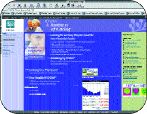

CIGNA Group Insurance (life, accident and disability) specialty program executives include (left to right): William A. Uzdzienski, director of underwriting; Carol Trentino, director of marketing; Larry R. Lang, national sales director; and Susan J. Latella, vice president.
When golf phenom Tiger Woods, only 25 years old, recently won the coveted U.S. Open golf tournament by a record-breaking 15 strokes, sports analysts immediately predicted a surge in interest in the sport among young people. Not only are more young people taking to the links, but drive by a recreation field on any given weekend and there will likely be a robust game of soccer, softball or baseball underway, or a parking lot packed with cars in front of a gym where basketball players are all dreaming of that game-winning slam dunk.
Organized and recreational sports programs in the United States are flourishing, with participants of both genders, of all ages, and from virtually all walks of life suiting up to compete for fun, for trophies, or for the love of the game. Yet sporting events, while perhaps drawing cheers from the sidelines, also create a potentially serious exposure to injury--an exposure agents can readily address through Participant Accident Insurance (PAI), underwritten by Life Insurance Company of North America, a CIGNA company, headquartered in Philadelphia. (CIGNA as used in the remainder of this article refers to Life Insurance Company of North America and not CIGNA Corporation.)
According to Bill Uzdzienski, director of underwriting for CIGNA's "Special Risk Accident Insurance Unit," PAI is designed to provide insurance protection not only for players and the teams involved in virtually any sport, but for participants in youth activities, groups, clubs, camps, day care centers, school-sponsored activities, and a host of other organized events. Likewise, the coverage is not limited to entities that have an ongoing schedule of events. It is applicable to almost any group whose interests are recreational, competitive athletic, social, charitable, religious, or educational.
PAI, stresses Uzdzienski, is an accident medical insurance product driven solely by the covered accidents incurred by participants involved in a given group activity or group setting. In some cases, low limit, short-term sickness benefits may also be available. PAI is written on either a primary, primary excess or full excess basis, with benefits payable for the eligible medical expenses incurred that result directly from a covered accident up to the accident medical maximum selected. PAI, Uzdzienski continues, is purchased by the organizing entity, with benefits payable in excess of any other health care plan or policy that covers the participant.
According to Larry Lang, CIGNA's national sales director for PAI, located in Chicago, CIGNA is a key player in the participant accident insurance arena, having achieved an estimated 15% to 20% penetration of a market that generates several hundred million dollars in annual premiums. The product is marketed by CIGNA through approximately 30 managing general agents around the country who currently draw business from more than 2,000 retail agents.
 Bill Uzdzienski says that more and more writers of CGL business are requiring Participant Accident Insurance as a "complement" to the insured's overall protection program.
Bill Uzdzienski says that more and more writers of CGL business are requiring Participant Accident Insurance as a "complement" to the insured's overall protection program.
"PAI represents tremendous potential to property/casualty agents, many of whom have overlooked the product in the past," Lang observes. "On commercial general liability (CGL) our product is often looked at as a buffer because it covers and pays claims that might otherwise hit the general liability insurer."
In fact, Uzdzienski reports that more and more CGL writers are requiring PAI as a "complement" to the insured's overall program of protection, which could result in a lower GL premium reflecting this additional layer of protection.
Lang also points to the role PAI can play to enhance the agent's product menu, which is becoming more and more critical in an environment in which one-stop shopping is the buzzword of the day. "PAI adds another important product to the agent's portfolio as well as an additional revenue stream to the agency," Uzdzienski continues. Likewise, he points out that the public relations benefits potentially deriving from PAI cannot be overstated. What better way to gain visibility among local groups, community events, and sports organizers than to be the agent who provides them with this needed coverage, asks Uzdzienski.
 "Participant Accident Insurance represents tremendous potential to property/casualty agents, many of whom have overlooked the product in the past."
"Participant Accident Insurance represents tremendous potential to property/casualty agents, many of whom have overlooked the product in the past."
--Larry Lang
William Flinker, vice president of MIC Insurance Brokerage, a mid-sized MGA headquartered in Naperville, Illinois, believes all retail agents should, at the very least, identify and form a strong relationship with a reliable PAI market. He observes that many retail agents have not become involved in PAI because they either lack the expertise or the time necessary to sell and service a product that may be needed by only a small segment of clients. Accessing PAI through an MGA seasoned in the coverage addresses these issues, says Flinker, who stresses that retail agents can have the best of both worlds--the expertise and servicing support of a skilled MGA, and highly competitive commissions.
Flinker, whose MGA derives an estimated 25% of its annual premiums through the sale of CIGNA's PAI product, with a specialization in youth sports programs, reports that growing numbers of retail agents are recognizing the importance of having PAI at their fingertips, knowing they will eventually be called upon to address the exposure.
"Virtually all agents in the country will have this type of risk walk into their office in some form or the other," Flinker says. "While it may be considered a small, nuisance sort of risk, if the agent doesn't know what to do with it, it could make the agency look bad. On the other hand, the agent who can provide a quick turn-around, hassle-free response to the exposure will look like a hero."
Flinker also points out that while PAI may be viewed by the majority of agents as a necessary product to fill in occasional coverage gaps, others are aggressively marketing PAI and deriving a significant source of revenue from it. He knows of several retail agents who have created niches within various sports and have built up $1 million books of business grown solely on PAI.
Regardless of the extent to which agents market PAI, Flinker believes "it's a great product to have in an agency's portfolio. Eventually, agents will run into it and whether they find addressing the exposure really hard or really easy will depend largely upon whom they choose as a partner."
Phil Munson, chairman of Health Special Risk, Inc., a Mendota Heights, Minnesota-based MGA specializing in the accident and health marketplace, also stresses the importance of identifying PAI writers and MGAs who are in the business for the long-haul. He reports that many companies "jump in and out of the PAI marketplace," with their underwriting appetites for the business driven largely by fluctuations in the marketplace. CIGNA, he notes, has been an active writer of PAI for some 40 years and appoints those MGAs to sell and service the business who have demonstrated a strong interest and expertise in the product.
Munson adds that the product, once on the books, typically "takes care of itself," exceeds retention levels of 90%, and has historically been characterized by low utilization levels. He also notes that some entrepreneurial agents have developed large, national PAI programs, or citing the example of one agent who moved from youth sports leagues to youth sports camp business, have successfully branched out from one PAI exposure to another.
Many of the 3,000 agents represented by Health Special Risk have been asked to address the PAI exposure at one time or the other, adds CEO Charlie Bell, who nevertheless observes with some concern that despite the growing need for PAI, "most agents still do not have it in their portfolios." He believes that those who do, however, are likely to find that their ability to respond to the need will potentially open doors to other insurance sales, or close the door on other agents just waiting to pounce when a coverage need can't be met.
"Many agents don't know too much about PAI because it's not considered a traditional line," says Bell. Yet he strongly believes that in many instances, the ability to bring yet another product offering to the table can tip the competitive scales in the retail agent's favor. Adds Bell: "It's nice to have as much in your portfolio as you can." *
